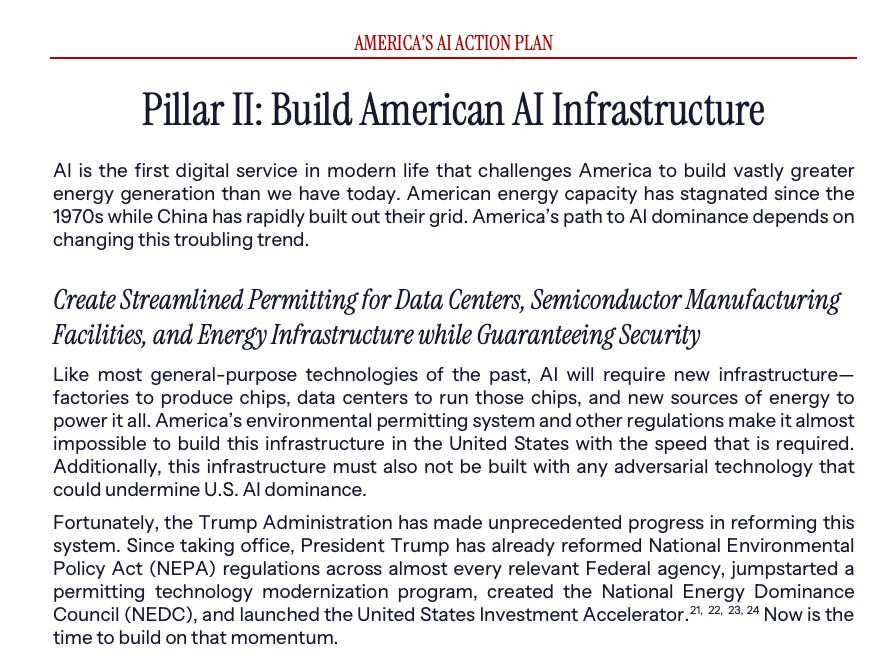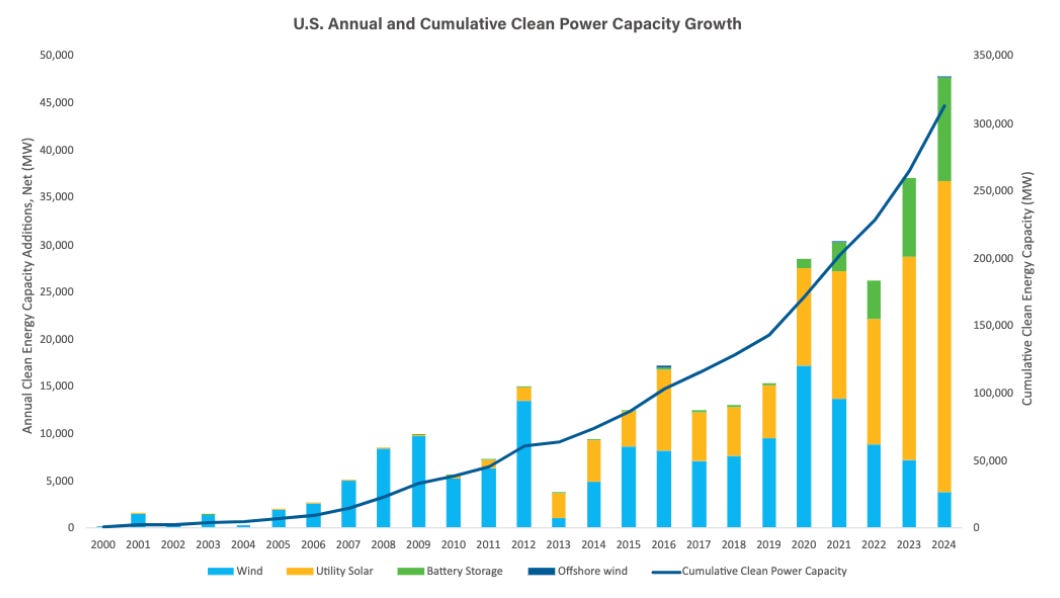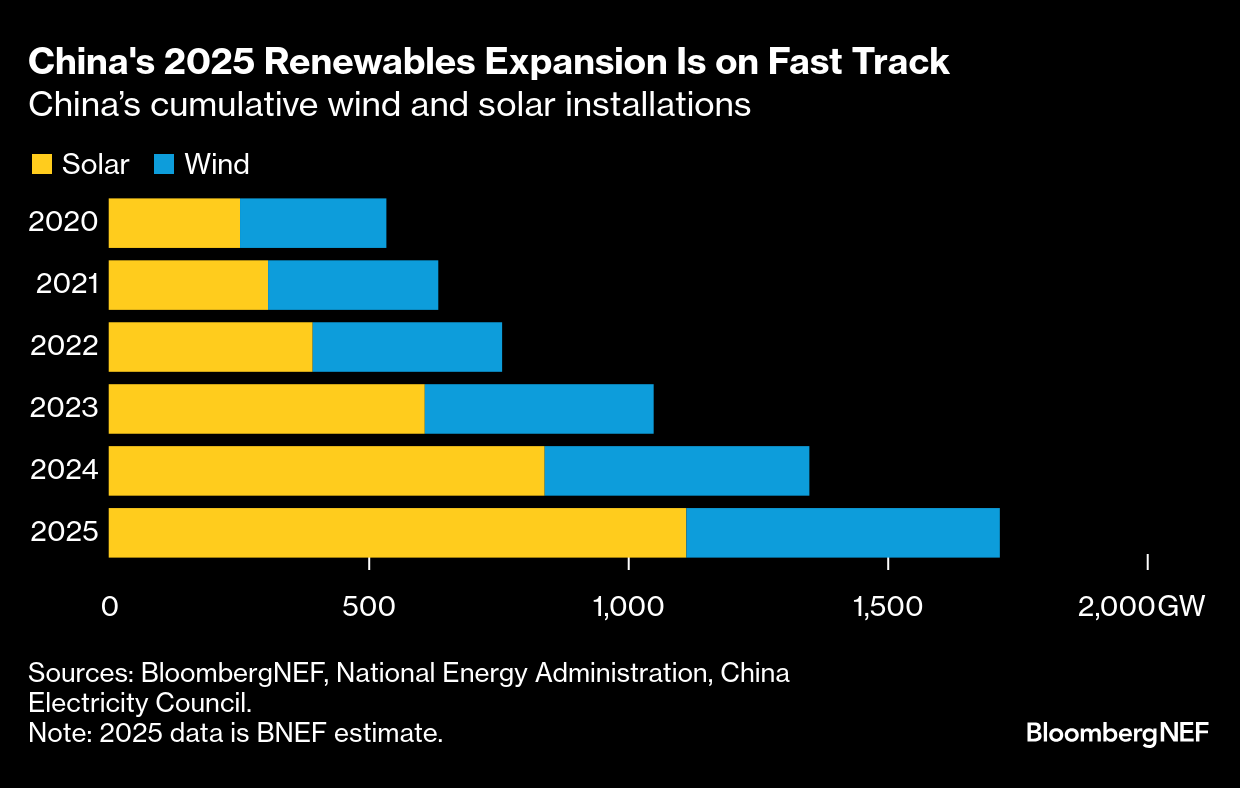We’re Putting Culture Wars Over Energy Again
You Can’t Run AI on Vibes and Natural Gas Alone
The Trump administration's new National AI Action Plan reads like a tech policy wish list: streamlined permits for data centers, fast-tracked chip manufacturing, enhanced geothermal and nuclear development. The document's language for energy is genuinely forward-thinking, acknowledging that "AI is the first digital service in modern life that challenges America to build vastly greater energy generation than we have today."
But there's a dangerous mismatch buried in the details. The plan prioritizes "reliable, dispatchable power sources" and embraces "new energy generation sources at the technological frontier", which is great. But it does nothing to streamline transmission lines, solar farms, wind projects, and other renewables that could actually deliver abundant, affordable electricity. And that’s a problem.
The White House’s new plan creates massive electricity demand while artificially constraining the fastest, cheapest ways to meet it. We need energy and permitting reform not just for oil and gas. And Democrats are finally waking up to the political opportunity this creates.
Demand Is Soaring. Prices Are Too.
U.S. electricity demand is surging at a pace not seen in decades. After 20 years of flatlining (thanks to investments in energy efficiency), power consumption jumped 2% in 2024 and transmission planners are forecasting an 8.2% increase over the next five years.
Meanwhile, retail electricity prices averaged 18.2 cents per kilowatt-hour in the first half of 2025, up 6.7% year-over-year, which outpaced inflation. Utilities have filed for nearly $29 billion in additional rate hikes for 2025 alone, citing demand growth and grid modernization costs. Americans have already seen prices increase an average of 9% since January!
Many have flagged that AI data centers could also use a lot more water, but that misses the forest for the trees. As Matthew Yglesias pointed out, water is not the limiting factor in this equation, it’s energy. Water for cooling is a small line item next to the massive electricity draw of running GPU clusters 24/7. And unlike water, which can often be reclaimed, recycled, or sourced variably, you can’t fake electrons. Data centers chase cheap electricity, not cheap water. That’s the real constraint—and the one that shows up in your utility bill.
The Council of Economic Advisers found that without massive new investment in generation, electricity prices in 2030 could be 9-58% higher as demand far outstrips available supply.
The Trump AI plan calls for categorical exclusions from environmental reviews for data centers and explores streamlined Clean Water Act permits for AI facilities. It even calls for making federal lands available for "data center construction and the construction of power generation infrastructure for those data centers."
That sounds comprehensive, but the devil's in the implementation. Right now, oil, gas, and mining projects (notably things Republicans culturally like) get the only truly streamlined federal permitting lanes. Clean energy projects, which made up 93% of all new generation added to the grid last year, still face years-long regulatory review processes.
If we're serious about “energy abundance,” instead of energy scarcity, we need permitting reform that covers all generation and transmission, not just extraction industries. The plan mentions using AI to "accelerate and improve environmental reviews" through DOE's PermitAI project, which is exactly the right idea. Extend that logic to wind, solar, batteries, advanced gas, small modular nuclear — whatever beats the cost curve should win on speed.
Image Credit: Clean Power
Dems Are Finally Speaking Up
This supply-demand mismatch creates a political opening that Democrats can (and should) exploit:"Democrats now have the high ground of price and Republicans are now the party of electricity shortages," Sen. Brian Schatz (D-Hawaii) said bluntly. "We're just not going to have enough electrons to go around and the prices will go up — and that will be 100 percent because Republicans passed this ridiculous bill."
Sen. Martin Heinrich (D-New Mexico) put hard numbers on the GOP's energy policies at a July Senate hearing. The Republican bill that gutted clean energy tax credits could add $16 billion to annual power costs in 2030 and $33 billion by 2035, he warned. Natural gas prices alone could jump 25% as demand outruns supply.
This marks a dramatic shift in Democratic messaging. Gone are the pleas about climate change (All true! But only motivates the current base) boastful talk of renewable energy targets. Instead, Democrats are all about costs: who's raising your rates, and who's trying to lower them.
"Bread and butter, kitchen table issues — costs, their electric bills — are not going to see relief from Republicans," Rep. Kathy Castor (D-Florida) told Politico. The party is centering their pitch on pure economics while scrubbing out climate buzzwords entirely.
By scrapping incentives for new power projects while energy demand surges, Republicans have virtually ensured a supply crunch that leads to higher prices.
Scarcity by … Aesthetic Preference?
The AI Action Plan isn't wrong to prioritize American tech leadership; the economic and national security stakes are enormous. Data centers and chip fabs deserve streamlined permitting because they're critical infrastructure for the economy.
But when you take a closer look, it gets a little stranger. It turns out Republicans have been focused on culture wars and blocking clean energy development for obscure, often aesthetic reasoning. To that point, Trump recently complained that wind turbines block the view from his golf courses. Yes, you read that right.This kind of aesthetic attack has become emblematic of a party whose energy ideology is completely divorced from reality.
While Trump complains about eye-sores, China is building out massive renewables capacity, they've also dramatically increased overall electricity generation, because they recognize that abundance, not scarcity, drives economic growth. They generate more wind electricity than the U.S. despite less favorable geography, and vastly more solar power. In fact, 74% of all solar and wind power projects being built globally are in China!
Image Credit: Energy Connects
Throttling cheap renewable deployment out of cultural spite is ridiculous. As Neil Chatterjee noted, the only viable path to meet AI's power surge is "using solar energy plus battery storage, with natural gas as backup." Blocking the cheapest options guarantees higher costs. This is probably the most plausible way forward for the near future, in hopes that one day, clean energy is bountiful enough where natural gas is a last case resort, or any usage is paired with carbon removal initiatives/programs.
Republicans have convinced themselves that solar and batteries are idealism that climate activists are forcing on America to bring down capitalism. They're trapped in an information bubble where they only hear from polemicists who call clean energy subsidies "fentanyl jobs" and describe solar development as "a cancer we have to get rid of." The notion that these technologies actually make energy cheaper for Americans hasn't penetrated the collective Republican consciousness. Democrats should continue to expose and capitalize off that gap.
This Is About Your Bills, Not Buzzwords
Democrats have stumbled onto a winning message by accident. By focusing on supply, demand, and household budgets instead of environmental virtue, they're speaking a language anyone who has ever paid an electricity bill can relate to.
Republicans spent decades positioning themselves as the party of energy abundance. But by knee-capping the cheapest forms of energy, they've handed Democrats a gift: the chance to become the party that actually delivers affordable electricity.






